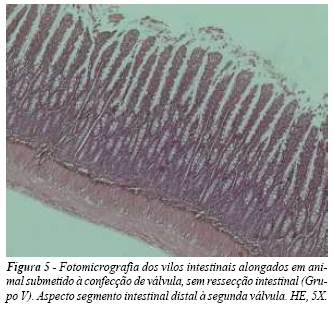BACKGROUND: to evaluate the role of artificial valves created by double circumferential seromyotomies in the villi length, in the small intestine diameter and in the weight of rats. METHOD: 40 rats have been distributed into four groups. The R Group animals were submitted to the resection of 50% of the small intestine, without the creation of valves. In the RV Group, two valves were associated to intestinal resection. In the V Group, two valves were created, without intestinal resection. The C Group provided the villi average height. Euthanasia was performed between 10 and 14 days after surgery. RESULTS: there has been an increase in villi length in Groups R, RV and V. Compared to the R Group, the proximal segment villi length was greater than the distal one. In V Group, the proximal segment villi length was smaller than the distal one. The intestine had a larger diameter than in the presurgical in R Group, and in the segments proximal to the first valve and distal to the second one, in Groups RV and V. Intestinal resection led to weigh loss in Groups R and RV, without differences among the groups. In V Group there has been significant weight gain compared to groups R and RV. Although they did not prevent weight loss in the animals submitted to resection, the valves did not cause greater loss than that of the resection itself, isolated. CONCLUSION: these valves seem to positively interfere in intestinal adaptation and might be included among the techniques of surgical intestinal rehabilitation, isolated or preceding interventions of intestine lengthening.
Small intestine; Short bowel syndrome; Artificial sphincters; Bowel resection; Intestinal Mucosal







